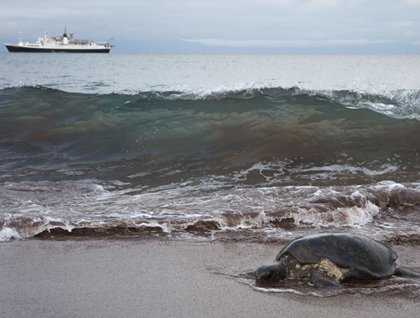Imagine a misty morning. The hidden sunrise is shedding a diffuse light through clouds over an isolated beach lined with mangroves on Santiago Island. Dark brown sand softly glistens as waves recede. You step onto the beach and notice a Pacific green sea turtle on the sand in the distance. The turtle is making her way back to the sea. You have time to savor the beauty of this creature: looking at the details of her carapace, the movement of her throat with each breath, the patterns she leaves behind her in the sand. Her return to the water takes time as she moves along with each surge in the surf, until finally, she enters the water and swims away.
This is the first of several sea turtles that you notice on this morning stroll. Most of them are just offshore, in groups of two or three. It is mating season for these marine reptiles, and you watch as joined turtles bob up and down in the water, changing directions with the movement of the female’s flippers as the male balances on top, using his flippers to grasp her carapace. Some that come too close to the shore to maintain their balance in the tumbling waves somersault through the surf and onto the sand, before returning to the water for another attempt.
Nearby, brown pelicans are feeding, flying up and diving down in unison along the length of the beach. The sky begins to clear and you notice a rainbow along the horizon, framing the National Geographic Endeavour, your home for two weeks while traveling through these islands. Perched high in a mangrove tree, a Galapagos hawk watches as you board a Zodiac and leave Espumilla beach as you found it, secluded and pristine. It’s been a stunning morning, and you haven’t even had breakfast yet.
Hours later, on another side of Santiago Island the sun sets as you wander along tide pools of black lava. The incoming tide causes water to rise and fall in the crevices of lava tubes more dramatically as the afternoon progresses. Galapagos fur seals swim through the dark aqua water below as others sleep along shelves lining the sides. Herons can be seen feeding on fish as yellow warblers flit here and there hunting small insects. The afternoon light casts a dramatic light on hundreds of Sally lightfoot crabs which shine brilliantly red against the dark black shoreline. As you look closer, you can also see the subtle texture of very well camouflaged marine iguanas along the lava. The sun sinks behind a cloudbank as you depart Puerto Egas, leaving the sky with traces of greys, purples, and pinks.
Two outings on one island leave you with distinct memories that might sound like a dream had you not been there yourself. The magic of the Galapagos continues to amaze as you add Santiago Island to the list of islands visited on this epic expedition.







